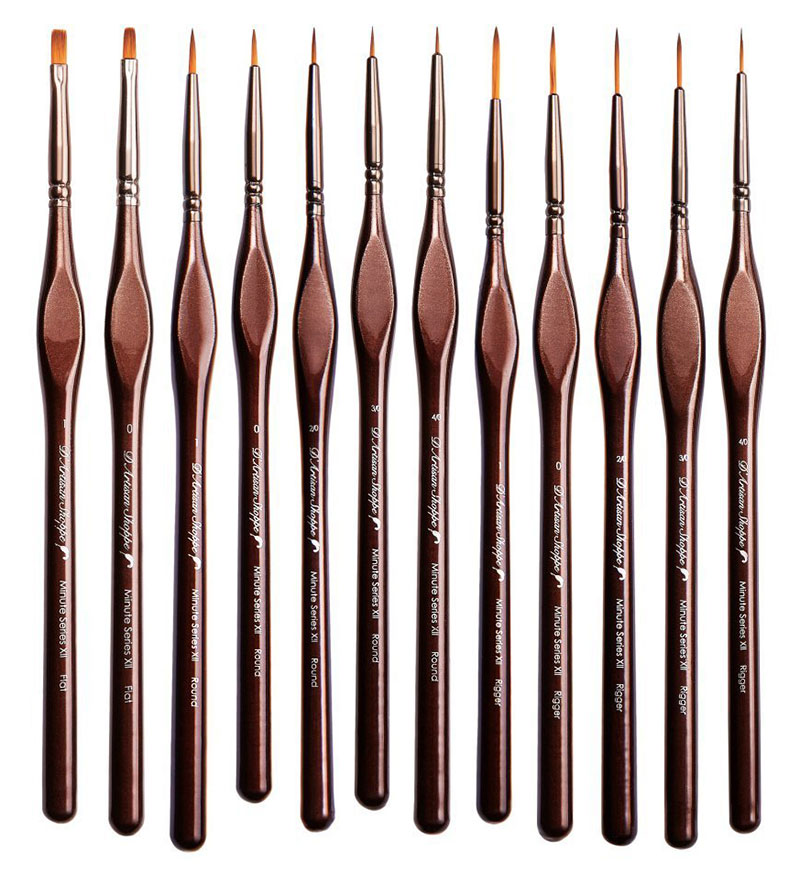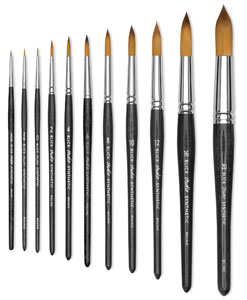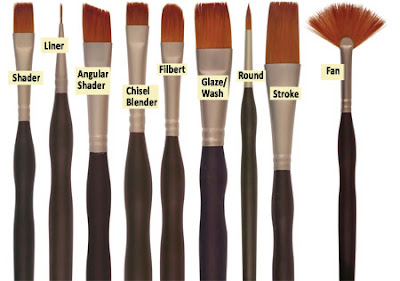Types Of Paint Brushes For Art
Flats are the types of paint brushes you’ll use the most often in your painting projects. You’ll use them for basecoating, floating, strokework, blending, washes and varnishing. As you can see, they’re very versatile. FILBERT, CAT’S TONGUE & OVAL WASH. A filbert brush is a type of flat brush which has medium to long hairs that come to a rounded point or an oval-shaped end. It gives a lovely thin line when used on its side and paints broad brushstrokes when used flat. WIDE RANGE OF APPLICATION: Craft acrylic paint brushes can be used as detail brush, miniature paint brushes, acrylic brushes for nails, for drawing thin and long continuous lines, for.
Brushes list you need for learning to paint.
Here is a list of brushes for painting landscapes wet on wet in oils and acrylics.
There is no need to buy expensive brushes for learning to paint in oil or acrylic.

2 inch house painting brush.
3/4 inch house painting brush.
Large round hog bristle brush.
Large flat hog bristle brush.
Small fine hair brush.
Medium sized fan brush.
The bristles need to be firm.
Painting knife. (We will cover them last)
Read on for more about items in this brushes list
The 2 inch house painting brush
1 inch or 3 inch will do, the 2 inch house painting brush does not need to be exactly 2 inches wide.
The bristles need to be soft hair or nylon, black, brown or white, but not too soft like a makeup or shaving brush.
The thickness does not matter but later on you might find you prefer thick or thin brushes. I like both.
The thick brush applies more paint quicker while the thinner brush gives better reflections, but the difference is minimum.
The best place to buy your brush is a handy man or hardware store, in the house paint section.
Similar brushes are sold in art supplies stores but do not seem to be as strong as the house painting brushes.
Some 2 inch brushes from the art supplies store are often too soft and go mushy when loaded.
We use this 2 inch brush to paint in our sky, water, put reflections on our water. it is also used to block in the trees and to produce foliage on larger painting. (On large murals I use a 5 inch brush and sometimes a roller).
It is useful to have 2 of these brushes. Keeping one for skies and the other for darker colors. This saves time cleaning brushes in the middle of a painting.
The 3/4 inch house painting brush
The 3/4 inch house painting brush should be of similar quality as the 2 inch brush and need not be exactly 3/4 inch.
It is used for painting the larger foliage in the foreground and also for blocking in on paintings.
Click for a closer look.
The large round hog bristle brush
The large round hog bristle brush is for dabbing on the foliage. It may be used for many purposes but it is the easiest brush to use when painting foliage.
Click the image to see more.
Don’t buy the pointy type of brush.
I have always advised others to use a size 12 but things have changed and sizes now vary as does the quality.
So the description of a good brush is:- a big round hog bristle brush with a ferrule width of about 5/8 inch. They usually have white bristles, long pale wooden handle and are made in China.
Do not buy the pointy ones for a foliage brush although you could trim it with scissors if need be.
This brush is very common in Australia but I could not buy one in Thailand.
They are not an expensive brush and often can be found in hardware stores etc.
If you cannot find one then try using your 3/4 inch house painting brush to paint the foliage.
When using the round brush or the 3/4 inch brush for foliage it is important to load and unload the brush in the right way.
Firstly saturate the bristles with dark paint, and then clean the brush by squeezing it and pulling it through a clean rag. This will leave the bristles putty like and making it easy for you to squeeze them into a chisel point. With a well shaped brush you pick up your dark and light colors on different sides of the brush and keep the colors separated. Repeat the squeezing and cleaning process every time you pick up more paint. This is a habit you should get into if you wish to paint crispy looking foliage. If you do not clean and re-shape the bristles before picking up paint, your colors will become muted and your foliage will look dull and be lacking depth.
The large flat hog bristle brush
The large flat hog bristle brush is available everywhere. We use it for painting mountains, huts, tree trunks, soil and everything in between including blocking in the distant trees. Like the round brush it is usually white bristled with a long pale wooden handle. Again you need to clean the brush before re-loading and wipe it clean often when blending.

The small fine hair brush.
The small fine hair brush is used for painting the twigs and small branches.
Find a size with more than a few hairs which you could imagine to be the width of the middle sized branches in a painting as you will use only the very tip hairs for the finer branches.
Let us say the size could be between one and two match heads thick at the thickest part of the bristles.
The bristles are very soft and this brush must be cleaned well between painting sessions.
They cost from about 50 cents for a small brush and the more expensive brushes will give you a finer line if needed.
The small fan brush
The small fan brush is used for painting grass as well as falling water, ferns and some other foliage.
Warning
A very soft haired fan brush is now on the market. This very soft brush is of no use when painting in oils or acrylics. Look for a firm bristled brush.
The prices vary and an expensive brush will wear our just as quick as an inexpensive one. I like a medium sized fan brush because it can do any job but might take more brush strokes than a larger one.
If you cannot find a fan brush you can make one by driving a clout nail down the middle of a round brush and the bristles will fan out.
The painting knife
The painting knife is also in our brushes list.
A painting knife is not a palette knife but we do use it as a palette knife.
Palette knives do not have a cranked handle or a narrow tip.
The painting knife is cranked. This is to make it easy to pick the paint up and place the paint down without the handle getting in the way.
A flexible, pointed painting knife with about a 2 or 3 inch blade is ideal. The point is rounded.
You will become accustomed to using your own knife and you may find other shaped knives awkward to use.
Choose a knife you will want to use for both mixing and sculpturing the paint.
A bad habit.
Another point I must make is that you will come to have a favorite brush or brushes and after a while they will wear out. Don’t keep using worn out brushes because you will find you cannot use a newer brush in the same way as the old favorite brush.
This is a bad habit and will restrict your painting skills therefore it is better to have several brushes of the same kind.
Try to use the newer brush before your hand becomes reliant on the worn out or half worn brushes.
Beware.
Some non-art brushes are too soft and become a sloppy mess when loaded with paint (e.g. make-up brushes or shaving brush) some are too firm (e.g. car engine cleaning brush).
There are endless brands of house painting brushes which are a pleasure to use with oil or acrylic artist paint.
Soft nylon house painting brushes are ok but beware of the nylon brushes with what looks like a little knob on the tip of each bristle (Seen in Australia).
Be careful if working in oils and cleaning plastic or nylon brushes in turpentine. Plastic brushes might melt and the glue holding the bristles or a plastic handle can sometimes melt.

You may Comment below.

Go back to the top.
Go to – HOME – FREE LESSONS – ABOUT PAINTING – DIRECTORY OF PAGES – CONTACT LEN – LEN HEND SALES
Brushes list you need for learning to paint.
Here is a list of brushes for painting landscapes wet on wet in oils and acrylics.
There is no need to buy expensive brushes for learning to paint in oil or acrylic.
2 inch house painting brush.
3/4 inch house painting brush.
Large round hog bristle brush.
Large flat hog bristle brush.
Small fine hair brush.
Medium sized fan brush.
The bristles need to be firm.
Painting knife. (We will cover them last)
Read on for more about items in this brushes list
The 2 inch house painting brush
1 inch or 3 inch will do, the 2 inch house painting brush does not need to be exactly 2 inches wide.
The bristles need to be soft hair or nylon, black, brown or white, but not too soft like a makeup or shaving brush.
The thickness does not matter but later on you might find you prefer thick or thin brushes. I like both.
The thick brush applies more paint quicker while the thinner brush gives better reflections, but the difference is minimum.
The best place to buy your brush is a handy man or hardware store, in the house paint section.
Similar brushes are sold in art supplies stores but do not seem to be as strong as the house painting brushes.
Some 2 inch brushes from the art supplies store are often too soft and go mushy when loaded.
We use this 2 inch brush to paint in our sky, water, put reflections on our water. it is also used to block in the trees and to produce foliage on larger painting. (On large murals I use a 5 inch brush and sometimes a roller).
It is useful to have 2 of these brushes. Keeping one for skies and the other for darker colors. This saves time cleaning brushes in the middle of a painting.
The 3/4 inch house painting brush
The 3/4 inch house painting brush should be of similar quality as the 2 inch brush and need not be exactly 3/4 inch.
It is used for painting the larger foliage in the foreground and also for blocking in on paintings.
Click for a closer look.
The large round hog bristle brush
The large round hog bristle brush is for dabbing on the foliage. It may be used for many purposes but it is the easiest brush to use when painting foliage.
Click the image to see more.
Don’t buy the pointy type of brush.
I have always advised others to use a size 12 but things have changed and sizes now vary as does the quality.
So the description of a good brush is:- a big round hog bristle brush with a ferrule width of about 5/8 inch. They usually have white bristles, long pale wooden handle and are made in China.
Do not buy the pointy ones for a foliage brush although you could trim it with scissors if need be.
This brush is very common in Australia but I could not buy one in Thailand.
They are not an expensive brush and often can be found in hardware stores etc.
If you cannot find one then try using your 3/4 inch house painting brush to paint the foliage.
When using the round brush or the 3/4 inch brush for foliage it is important to load and unload the brush in the right way.
Firstly saturate the bristles with dark paint, and then clean the brush by squeezing it and pulling it through a clean rag. This will leave the bristles putty like and making it easy for you to squeeze them into a chisel point. With a well shaped brush you pick up your dark and light colors on different sides of the brush and keep the colors separated. Repeat the squeezing and cleaning process every time you pick up more paint. This is a habit you should get into if you wish to paint crispy looking foliage. If you do not clean and re-shape the bristles before picking up paint, your colors will become muted and your foliage will look dull and be lacking depth.
The large flat hog bristle brush
The large flat hog bristle brush is available everywhere. We use it for painting mountains, huts, tree trunks, soil and everything in between including blocking in the distant trees. Like the round brush it is usually white bristled with a long pale wooden handle. Again you need to clean the brush before re-loading and wipe it clean often when blending.

The small fine hair brush.
The small fine hair brush is used for painting the twigs and small branches.
Find a size with more than a few hairs which you could imagine to be the width of the middle sized branches in a painting as you will use only the very tip hairs for the finer branches.
Let us say the size could be between one and two match heads thick at the thickest part of the bristles.
The bristles are very soft and this brush must be cleaned well between painting sessions.
They cost from about 50 cents for a small brush and the more expensive brushes will give you a finer line if needed.
The small fan brush
The small fan brush is used for painting grass as well as falling water, ferns and some other foliage.
Warning
A very soft haired fan brush is now on the market. This very soft brush is of no use when painting in oils or acrylics. Look for a firm bristled brush.
The prices vary and an expensive brush will wear our just as quick as an inexpensive one. I like a medium sized fan brush because it can do any job but might take more brush strokes than a larger one.
If you cannot find a fan brush you can make one by driving a clout nail down the middle of a round brush and the bristles will fan out.
Good Paint Brushes For Art
The painting knife
Best Type Of Paint Brushes
The painting knife is also in our brushes list.
A painting knife is not a palette knife but we do use it as a palette knife.
Palette knives do not have a cranked handle or a narrow tip.
The painting knife is cranked. This is to make it easy to pick the paint up and place the paint down without the handle getting in the way.
A flexible, pointed painting knife with about a 2 or 3 inch blade is ideal. The point is rounded.
You will become accustomed to using your own knife and you may find other shaped knives awkward to use.
Choose a knife you will want to use for both mixing and sculpturing the paint.
A bad habit.
Another point I must make is that you will come to have a favorite brush or brushes and after a while they will wear out. Don’t keep using worn out brushes because you will find you cannot use a newer brush in the same way as the old favorite brush.
This is a bad habit and will restrict your painting skills therefore it is better to have several brushes of the same kind.
Try to use the newer brush before your hand becomes reliant on the worn out or half worn brushes.
Beware.
Some non-art brushes are too soft and become a sloppy mess when loaded with paint (e.g. make-up brushes or shaving brush) some are too firm (e.g. car engine cleaning brush).
There are endless brands of house painting brushes which are a pleasure to use with oil or acrylic artist paint.
Soft nylon house painting brushes are ok but beware of the nylon brushes with what looks like a little knob on the tip of each bristle (Seen in Australia).
Be careful if working in oils and cleaning plastic or nylon brushes in turpentine. Plastic brushes might melt and the glue holding the bristles or a plastic handle can sometimes melt.
You may Comment below.
What Are The Different Types Of Paint Brushes
Go back to the top.
Go to – HOME – FREE LESSONS – ABOUT PAINTING – DIRECTORY OF PAGES – CONTACT LEN – LEN HEND SALES
